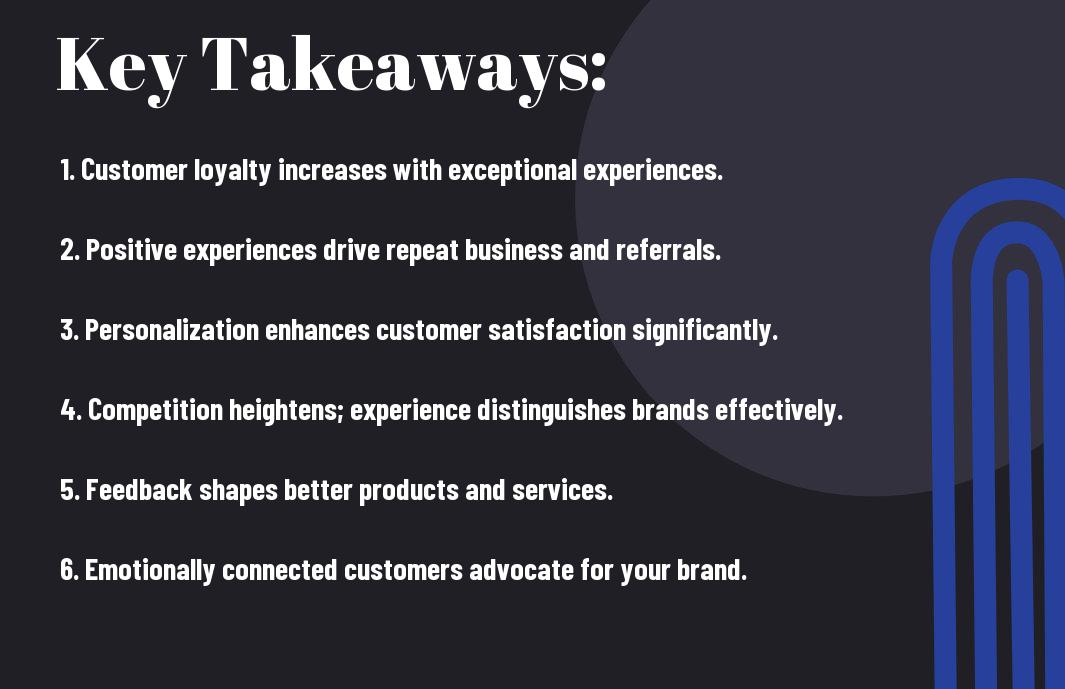
Most businesses today face intense competition, making it vital for you to prioritize customer experience. As consumer expectations evolve, your ability to provide exceptional interactions can significantly impact brand loyalty and revenue. By focusing on your customers’ needs and preferences, you not only enhance satisfaction but also differentiate your brand in a crowded marketplace. In this post, we will explore the reasons why elevating customer experience should be at the forefront of your business strategy.

The Evolution of Customer Experience
As the marketplace has changed, so too has the way customers interact with brands. Understanding the evolution of customer experience enables you to adapt your strategies to meet your audience’s needs effectively. From traditional interactions to the digital age, the expectations and preferences of consumers have transformed, making it vital for businesses to stay ahead of the curve.
Historical Context
Below the surface of modern commerce lies a rich history of customer interaction. Initially, businesses relied on face-to-face communication, and relationships were based on trust and personal connections. Over time, technological advancements introduced new channels, aligning customer experiences with broader societal changes.
Modern Expectations
By the time you engage with a brand today, expectations have shifted dramatically. Customers seek seamless, personalized, and timely interactions across various platforms. They have access to vast information and demand transparency, striving for convenience in every touchpoint.
Consequently, you need to recognize that today’s customers are more informed and empowered than ever before. With the ability to share experiences instantly across social media, their expectations for responsiveness and quality have significantly increased. Your customer experience strategies must prioritize both emotional and functional elements to foster loyalty and stand out in an increasingly competitive landscape.
The Impact of Technology on Customer Experience
Any successful business today must leverage technology to enhance customer experience. From enabling seamless communication to streamlining service delivery, technology plays a pivotal role in shaping how you interact with your customers. By adopting modern tools and platforms, you can create a more efficient and satisfying journey for your audience, ensuring that their needs are met promptly and effectively.
Digital Transformation
Across various industries, digital transformation has become a key driver of customer engagement. By embracing new technologies, you are not only optimizing operations but also enhancing the way customers perceive and interact with your brand. This evolution allows for faster response times, better support systems, and ultimately, a more satisfying experience that meets today’s fast-paced consumer expectations.
Personalization and Automation
At the heart of a positive customer experience lies the ability to personalize interactions. With the advancements in data analytics and automation, you can now tailor your offerings to meet individual preferences and behaviors. This means that you can automate repetitive tasks while still delivering a customized experience that makes your customers feel valued.
It’s important to recognize that personalization and automation go hand in hand to create more meaningful connections with your customers. By using data to understand their preferences and behaviors, you enable automated systems to recommend products or offer support tailored specifically to each unique individual. This not only enhances the customer experience but also fosters loyalty, as customers are more likely to return to a brand that understands and caters to their specific needs.
The Role of Customer Feedback
Many businesses are recognizing that customer feedback is not just a formality; it’s a fundamental aspect of improving your customer experience. When you actively seek and listen to your customers’ insights, you gain invaluable information that guides your strategies. This transparency fosters trust and engagement, making customers feel heard and valued. Ultimately, by prioritizing customer feedback, you can create a better alignment between your services and your audience’s needs.
Collecting Insights
By employing various feedback channels such as surveys, social media, and reviews, you can gather meaningful insights that reflect your customers’ views. It’s vital to be proactive in asking for feedback to understand what your customers appreciate and where you fall short, allowing you to effectively tailor your approach to meet their expectations.
Implementing Changes
With the insights gathered from customer feedback, you can implement changes that significantly enhance their experience. This approach not only addresses specific pain points but also helps in building loyalty and trust among your customers.
The adjustments you make based on customer feedback can range from minor tweaks in the user interface to larger operational changes. The key is to analyze the data comprehensively and prioritize the changes that will have the most impact. Engaging in regular check-ins after implementing these changes can also show your customers that you value their input, fostering a sense of partnership that can enhance their overall experience with your brand.
Building a Customer-Centric Culture
Unlike traditional business models that prioritize profits, a customer-centric culture places your customers at the heart of your operations. It requires a shift in mindset, enabling your organization to fully understand and address the needs of your customers. By fostering a culture that prioritizes feedback and continuous improvement, you not only enhance customer relationships but also drive long-term business success.
Leadership Commitment
Along your journey to creating a customer-centric culture, leadership commitment plays a significant role. It’s necessary for you and your leaders to embody the values of customer service, setting the tone for the entire organization. When leadership prioritizes customer experience, it signals to the entire team that this focus is a fundamental part of your business strategy.
Employee Engagement
Engagement is another vital aspect of building a customer-centric culture. When your employees feel valued and connected to the company’s mission, they are more likely to deliver exceptional customer experiences. Providing opportunities for feedback, recognizing achievements, and fostering collaboration can empower your team to take ownership of customer interactions.
Employee engagement significantly impacts how your team interacts with customers. When you invest in your employees’ well-being and professional development, you create a motivated workforce eager to exceed customer expectations. An engaged employee not only delivers better service but also acts as a brand ambassador, enhancing the overall perception of your business and contributing meaningfully to creating a loyal customer base.
Measuring Customer Experience Success
All businesses seeking to enhance customer experience must implement effective measurement strategies. By analyzing your current performance, you can identify areas for improvement and ensure that customer expectations are being met. Tracking and evaluating key metrics allows you to refine your approach, enabling you to build strong customer relationships and boost loyalty in today’s competitive landscape.
Key Performance Indicators
Below are several key performance indicators (KPIs) that can help you gauge the success of your customer experience efforts. Metrics such as Net Promoter Score (NPS), Customer Effort Score (CES), and Customer Lifetime Value (CLV) are crucial for understanding how well you are meeting your customers’ needs and expectations. By regularly monitoring these indicators, you can make informed data-driven decisions that improve overall satisfaction and engagement.
Customer Satisfaction Surveys
Above all, customer satisfaction surveys play an integral role in measuring and understanding your clients’ experiences. These surveys provide you with direct feedback, helping you to assess how satisfied your customers are with your products and services. They also enable you to gather actionable insights to enhance your offerings and streamline processes for a better overall experience.
Customer satisfaction surveys can take various forms, including online questionnaires, telephone interviews, or in-person feedback sessions. You should design these surveys to cover crucial aspects of your service, from product quality to customer support. Analyzing the results will empower you to pinpoint strengths and weaknesses, ensuring you’re consistently aligning your strategies with customer expectations and enhancing their overall experience with your brand.
Trends Shaping the Future of Customer Experience
To thrive in today’s competitive landscape, businesses must adapt to emerging trends that reshape the customer experience. Personalized interactions, real-time feedback, and the integration of advanced technologies like artificial intelligence are defining how you engage with your customers. Staying ahead of these trends helps you foster stronger relationships and enhance brand loyalty, setting you apart in the marketplace.
Omnichannel Experiences
At every touchpoint, customers expect a seamless interaction with your brand. Creating omnichannel experiences means integrating all communication channels, from social media to in-store visits, ensuring your customers receive consistent messaging and service. This approach not only improves convenience but also makes interactions more enjoyable, ultimately enhancing customer satisfaction and retention.
Sustainability and Ethical Practices
To resonate with conscious consumers, your business must prioritize sustainability and ethical practices in all operations. This includes sourcing materials responsibly, reducing waste, and ensuring fair labor practices throughout your supply chain. As more customers seek brands that align with their values, demonstrating your commitment to sustainability can significantly enhance your brand’s reputation and your customer experience.
Experiences that emphasize sustainability and ethics reflect your brand’s values, creating a deeper emotional connection with your customers. By being transparent and actively promoting environmentally friendly practices, you invite your audience to engage with your brand on a more meaningful level. Ultimately, adopting these principles not only benefits the planet but also attracts customers who appreciate and support your ethical efforts.
To wrap up
Presently, enhancing customer experience is paramount for your business’s success in an increasingly competitive landscape. You must recognize that satisfied customers are more likely to return and become brand advocates, which can significantly impact your bottom line. By prioritizing their needs and preferences, you foster loyalty and differentiate your brand. In this evolving market, where choices are abundant, focusing on exceptional customer experiences is not just an option; it is necessary for sustainable growth and long-term success.
Leave a Reply